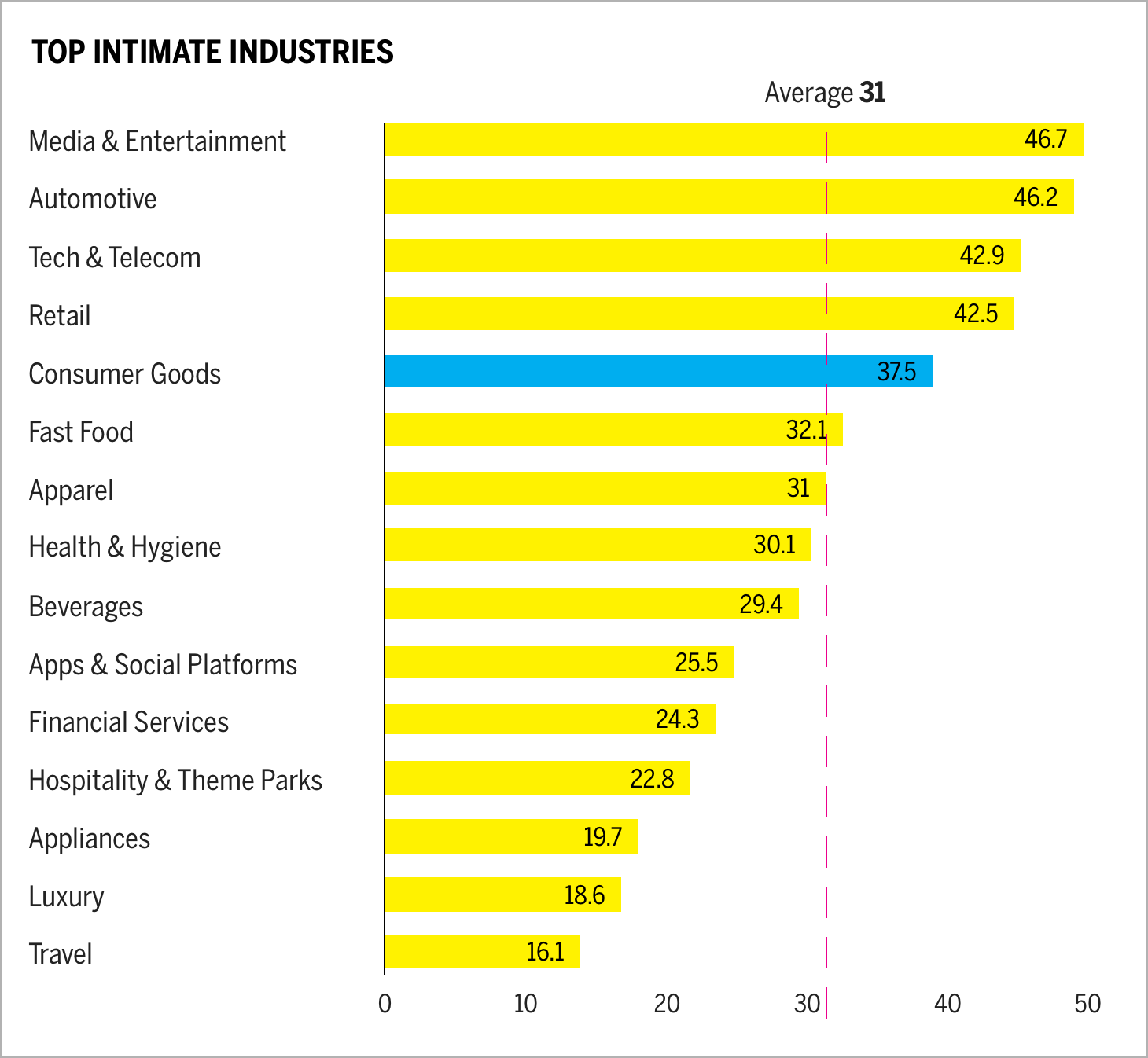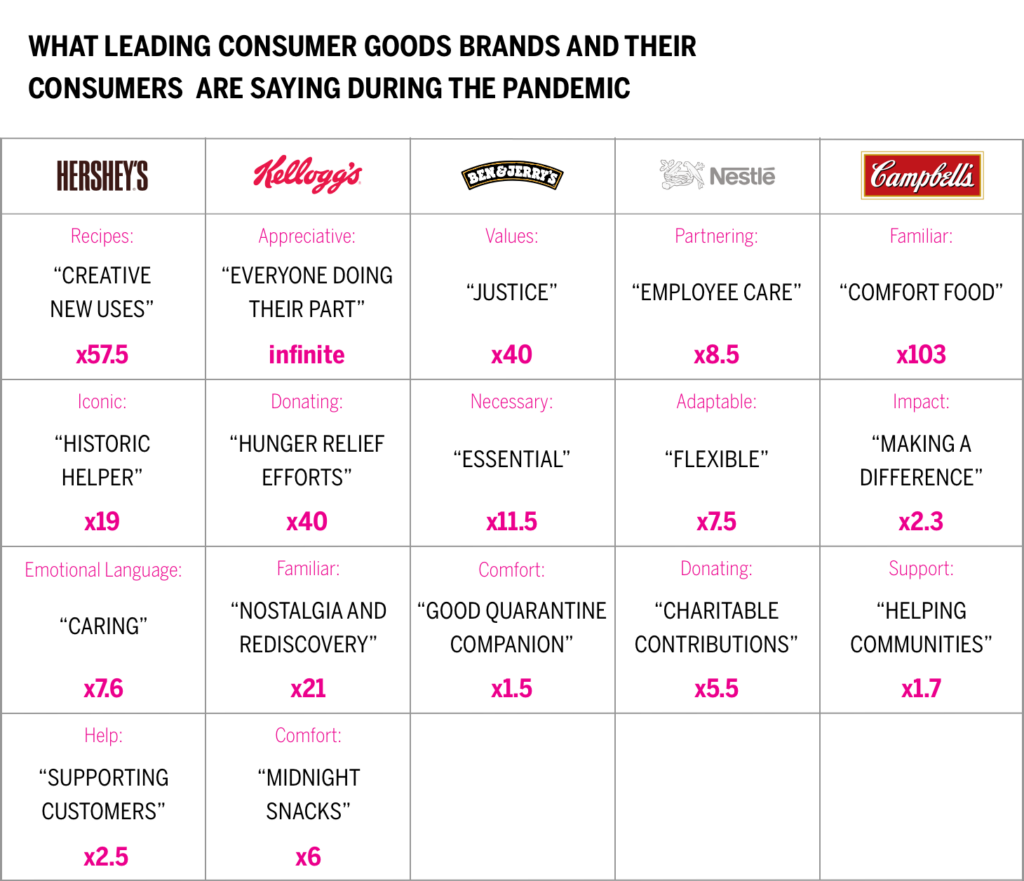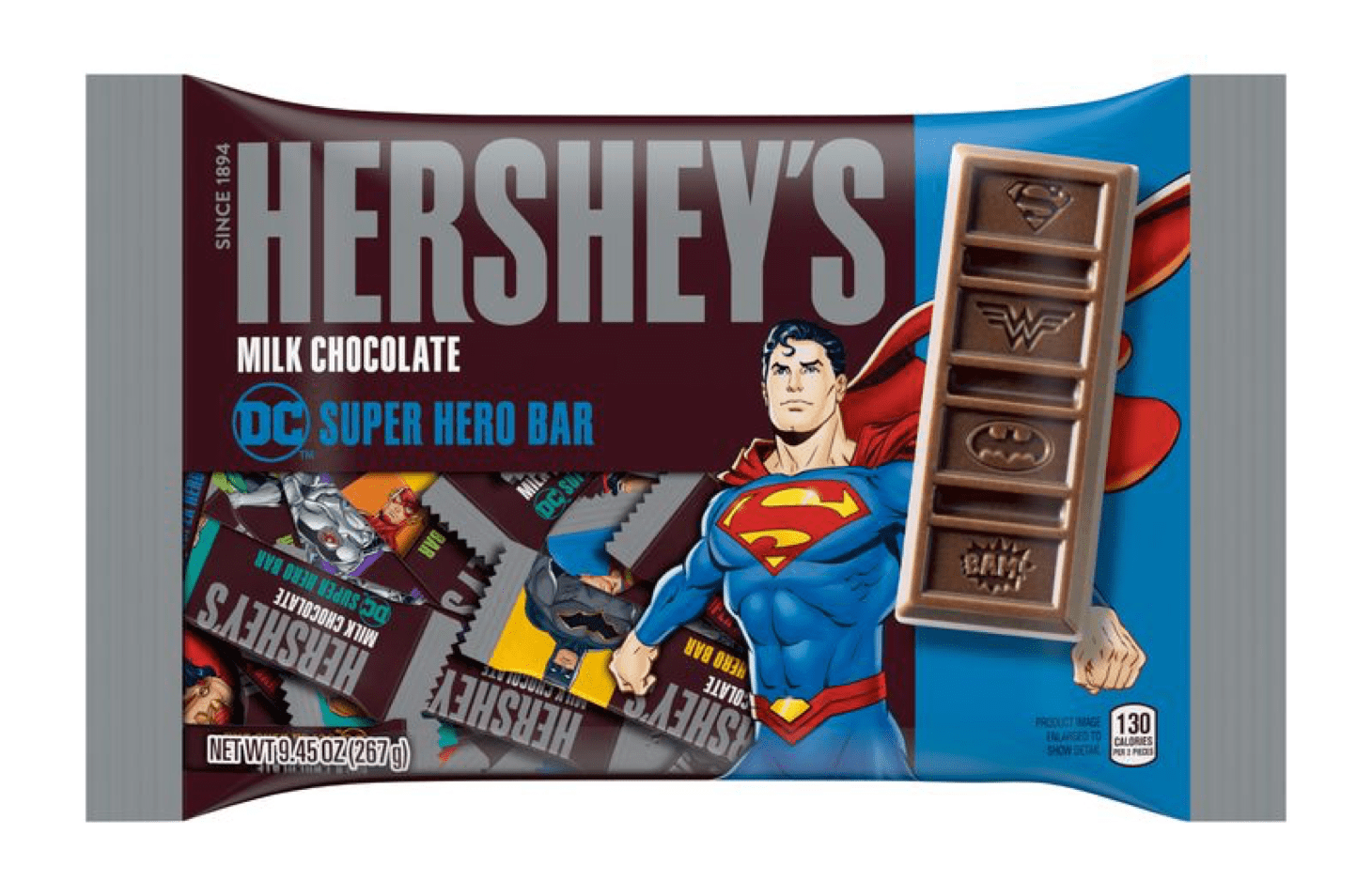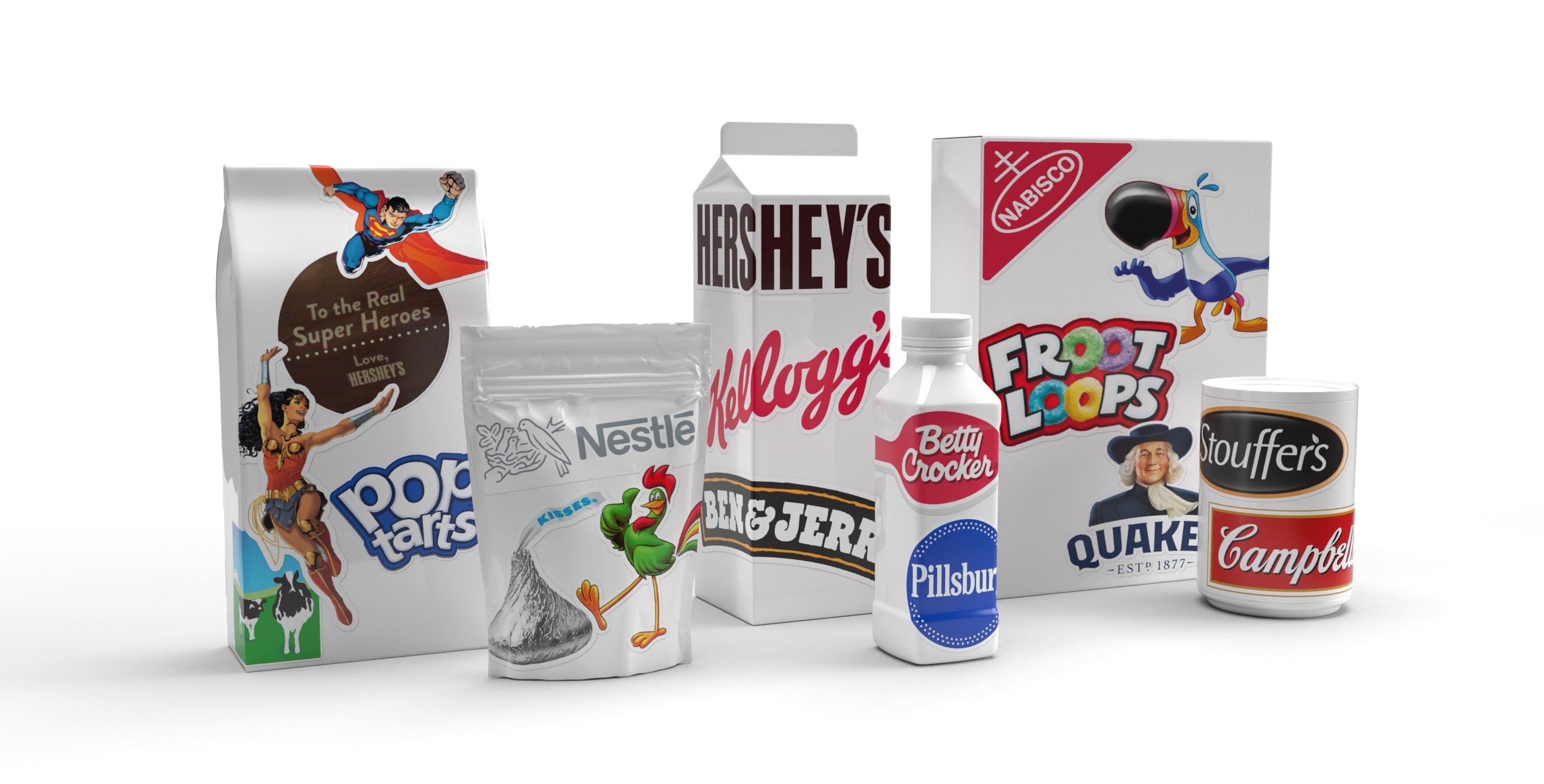Overview:
- The consumer goods industry ranks 5th out of 15 industries for building Brand Intimacy.
- Nostalgia, focusing on memories of the past and the warm feelings associated with them, is the top archetype in the industry.
- 5 out of the 10 brands that rank highest for nostalgia in our study of nearly 400 brands are consumer goods.
- Consumers are highlighting their renewed pleasure in comfort foods, while companies speak in different ways about how they are offering help in light of the coronavirus.
As the world continues to struggle in the face of the COVID-19 pandemic and businesses and their brands face unprecedented challenges, we are sharing our insights into how brands can refocus, enhance, or optimize for the marketplace we are eager to see return.
For context, our annual study of intimate brands, the largest of its kind, launched on Valentine’s Day 2020 with research fielded this fall. Because we are all facing a new COVID-19 affected-reality, we are offering highlights of brand performance both before and after the pandemic emerged.
Before the crisis, consumer goods brands, largely iconic and established, were maintaining the status quo while looking for new niche offerings to appeal to every palate and diet. These brands have always done reasonably well in our Brand Intimacy Study, ranking 5th out of 15 industries for the last several years.
With stay-at-home orders in place for many states over the past few months, we are separated from working, socializing, and the lives we all were accustomed to. We have not been able to dine out, and grocery shopping, once taken for granted, has now become something we line up for as we maintain six feet of distance between each other, and sanitize all items afterwards. Consumer goods have become essential throughout this ordeal, and are a growing source of comfort.
Category Performance

The consumer goods industry ranked 5th out of 15 industries.
For the consumer goods industry as a whole, nostalgia is the dominant archetype. This means focusing on memories of the past and the warm feelings associated with them. This strength is increasingly relevant in today’s trying times when people are turning to what’s familiar and comforting. In terms of the stages of intimacy, which measure the intensity of brand relationships, brands in this industry are above the 15-industry average, particularly in sharing, the earliest stage of Brand Intimacy.

The consumer goods industry creates stronger bonds than most industries.
Consumer goods also perform better than average in their ability to establish immediate emotional connections, at 42.5 percent compared to the 15-industry average of 38.5 percent. What’s more, given the fact that many of these brands have been in business for decades, if not centuries, the category ranks #1 in having the most long standing customers, of 10 years or longer.
Pandemic Boom
Unlike many industries that have faced hard times as a result of the pandemic, consumer goods are seeing a boom. Time spent indoors has caused us to spend more on groceries.1 Initially, Americans stocked up on essential pantry items and shelf-stable foods, uncertain when they might be able to return to stores or restaurants. Now with stay-at-home orders extended in many locations, consumers are also purchasing for pleasure and comfort, with a surge of snack food as well as a nostalgic return to food from our childhoods.2
Campbell’s soup sales increased 59% in March from a year earlier.3 General Mills said sales grew by 45% in March and 32% in April compared with the same periods in 2019.4 This is causing increases in production and manufacturing needs. Mondelēz International (parent company of Oreos, Cadbury, and Ritz crackers, among many other brands) has hired 1,000 more workers for “front-line teams” in manufacturing, sales, and distribution to get snacks onto store shelves faster.5
The current voice of consumer goods brands
We’ve augmented our Brand Intimacy research (fielded in November 2019) with social listening research we’ve captured recently (the week of May 4). We studied the top 5 ranking consumer goods brands (Hershey’s, Kellogg’s, Ben & Jerry’s, Nestlé and Campbells) regarding communications on their websites related to Covid-19 and outbound social conversations on Twitter. The analysis encompassed 561,094 words.
It is important to note that social listening data aren’t directly related to Brand Intimacy measures, although we hypothesize that the sentiment measured through the Internet and social media will have an effect in future Brand Intimacy quotient scores and rankings.
Our topline findings:
Each of the five brands has elected to take a different strategy relative to COVID-19. Interestingly, Kellogg’s and Ben & Jerry’s both feature communications related to the coronavirus on their consumer sites, while Hershey’s, Campbell’s, and Nestlé have significant initiatives, but only on their corporate sites.

Different areas of focus among the top 5 brands
This chart demonstrates a comparison of the top 5 most intimate consumer goods brands on the web.6 It shows how these 5 leading brands are communicating and how they are being talked about during the coronavirus pandemic. We are able to see the number of appearances of key themes for each brand and the relative differences based on the other brands reviewed (i.e., Ben & Jerry’s speaks 40 times more on justice than the competition).
Hershey’s leverages its history of support, including helping Americans through the Depression and World War 2. Kellogg’s focuses on how they are thankful to all those doing their part, from their employees to other essential workers. Ben & Jerry’s has focused communication on racial and economic justice during the crisis. Nestlé mentions their stability and their ability to adapt, while Campbell’s highlights their impact on communities.
Consumers tend to have more practical concerns that relate to the foods themselves; creative new uses for Hershey’s cocoa powder or syrup and the rediscovery of Pop-Tarts and Fruit Loops. People consider Ben & Jerry’s an essential food item and good company during quarantine. Nestle’s charitable contributions and its protection of its employees are getting attention, and Campbell’s Soup is being highlighted as the ultimate comfort food.
Consumers on social media are generally talking about how these brands are helping them cope. There is a clear link from food as soothing to the rediscovery of foods from our past. People are taking pleasure in posting recipes and ideas for new snacks and commiserating on the crisis and sharing in the pleasures of comfort food.
Brands in this industry have not been as overt as others in changing their advertising or promoting how they are making a difference. Frito-Lay has been among the only ones that have created a specific media campaign.
Hershey’s has pulled spots of people interacting and focuses now on product advertising; however these ads do not mention anything about today’s realities.7

Interestingly, Hershey’s has chosen a more direct way to make a statement. They have joined forces with DC Comics for limited-time superhero chocolate bars that will be given to coronavirus health-care and emergency service workers before before landing on the shelves.8
Conclusion: The new essentials
Consumer goods have seen dramatic growth during the coronavirus. We have turned to processed food for comfort and calm. And generally speaking, these brands have kept pace and remained in stock, helping maintain strong emotional connections with their users. These brands have become essential to us as we binge-watch our favorite series, as we relieve stress with a midnight snack or a quick and easy meal, reminding us of our youth and simpler times.
As states begin to reopen, it will be interesting to see how our relationship with these brands may change. Will it go back to what it is before Covid-19, when these foods were occasional treats? Or will their ability to help see us through this crisis create stronger usage and more powerful bonds? Will the impact of the coronavirus require many of us to seek continued comfort, even after the stay-at-home orders have lifted? Whether short-term or not, consumer goods brands have helped many during these trying times, and it is likely consumers will remember and continue to deepen their emotional attachments with the brands in this space.
Read our detailed methodology here, and review the sources cited in this article here.
Check out our annual study and rankings of intimate brands. Visit our most recent rankings of intimate famous figures, BFF. Our Amazon best-selling book is available at all your favorite booksellers. Additionally, MBLM offers Custom Dashboards, providing extensive data for brands included in our annual Brand Intimacy Study. To learn more about our Agency, Lab, and Platform, visit mblm.com.
